What to Expect From a High School Trip to France With ACIS

Paris. The name evokes images of the Eiffel tower, the Champs-Élysées, the Louvre, bistros with café au lait and croissants. All of us have this magical if not mystical wonder when we think of the “City of Light”. For these and many other reasons, France is one of the top educational travel destinations for students and teachers. Whether you are a French teacher, French student or simply a curious traveler, France has much to offer. Our classic high school trips to France provide plenty of options to choose from as a first introduction to this country.
- Paris
- Giverny
- Les Andelys
- Rouen
- Jumieges
- Honfleur
- Normandy Beaches
- Arromanches
- Bayeux
- Pointe du Hoc
- Mont St. Michel
- St. Malo
- Loire Valley Châteaux
- Chartres
Paris
As you arrive in Paris with your group you will get your first introduction to “La Cité de la Lumière”. A very friendly walking city making it easy to navigate by foot and subway. Walking allows you to get a good sense of any city. Our senses start to tune to the new sights and sounds. The atmosphere, the vibe is certainly distinct. Paris will stand out. Cafés, bistros, shops, museums, gardens and ‘bouquinistes’ line the streets.
Of course, the iconic landmarks will stand out. Students will notice La Tour Eiffel, the Louvre, Montmartre, l’Arc de Triomphe and the Champs Élysées. Their senses alighted by the vibrant effervescence of the city.
The city has a distinct feel. Visually, the roof lines and narrow streets and sculpted stone facades paint a visual canvas for the senses. We usually start the first day with a tour of one of the local artists’ areas. An expert guide will take you around one of Paris’ iconic artistic neighborhoods. They discover what inspired some of the most renowned artists from Picasso to Seurat and more.
Haussmann
A tour of Paris with a local tour guide is next on the itinerary. Students are regaled with stories of the city once known as Lutece. Paris as we recognize it is the city of Baron Haussman the architect. The look and feel of the city today is due in great part by Haussmann’s design. Today’s Paris is a stark contrast to what it was before in the 1830s and 1840s. Haussmann’s plan made room for wider streets to allow easier movement of horse and buggies at the time.
Most of the apartments we notice on our walks are Haussmann buildings. He treated buildings as extensions of the landscape. It’s a distinctive signature style and special to Paris.
On the tour you get to see: Les Invalides, Napoleon’s final resting place, Notre-Dame de Paris now undergoing major rebuilding since an accidental fire destroyed the roof. L’Hotel de Ville, Les Marais, Pompidou.
Of course the most famous museum in Paris, and arguably the world is the Louvre. During a visit you explore galleries and the history of the museum itself. Here students get to experience the full spectrum of art history under one roof.
There are also some off the beaten path places like the “Piscine Josephine Baker”. Originally known as Piscine Deligny, it was an oasis to cool off during the hot summer months in the early 1900’s.
Paris to Normandy
As you leave Paris, you head north loosely following the winding Seine river. The Seine river starts near Dijon, passes through Paris and winds up to the English Channel. Here are some notable locations to keep in mind.
Giverny – Monet
The founder of “Impressionism”, Oscar-Claude Monet would open the way for modern art. His style and created an artistic movement. Capturing light was at the heart of the style. Many of his works use the same subject but captured at different times of day to reflect the changing light (see the Cathedrale de Rouen). His body of work is significant and impacted future generations of artists. Giverny was his home. The gardens there inspired his water lilies series.
Les Andelys – Château Gaillard
Perhaps one of the most underrated sites on the road to Honfleur is Les Andelys. Hidden in the valley of the Seine is an important chateau. Richard the Lionhearted’s keep here is more of a fortress than a castle. When it was built it was said to be the most advanced and impenetrable structures ever built.
Started in 1196 construction only takes 2 years. Richard did not get to benefit from the castle as he would die in 1199. It is on King John to defend Normandy.
To this day its whitish color stands out as soft chalk is used in the construction. In the quest of the French to regain the duchy of Normandy, the castle defense stood in their way. From 1203 to the spring of 1204, a siege was laid. Then a weakness is found and french soldiers clamber through a latrine chute. They gain access and open the gates. From March 1204 and on Normandy returns to French rule for a few centuries
Chateau Gaillard offers a great tour. Your guides weave the stories of the siege of the castle and their tales take us back to the 1200s.
Rouen – Cathedral
Everyone thinks of Joan of Arc when Rouen is mentioned. The Cathedral is also an impressive example of gothic architecture. Capital of Normandy, it was one of the largest cities in Europe during the 13th and 14th centuries. Both the English and French crown would fight over Rouen and Normandy for centuries.
Jumieges – Abbey
The first abbey dates to 654. The ruins here date back to 942. The consecration of the abbey is in 1067 by William the Conqueror. It was pillaged and destroyed by the vikings in the 9th century. The abbey was a great center of religion and learning in the 10th and 11th centuries. The ruins are 88 meters long and the facade towers reach 46m. It is a unique opportunity to walk among these ruins and take a step back into another century.
Honfleur
This quaint town is at the intersection of the Seine and English channel. It has a small sheltered harbor, the vieux-bassin, where many artists capture the unique charm of the picturesque town. Walk the narrow streets and stop by Saint-Catherine’s Church. The roof was built using maritime ship building technique making it look like 2 inverted ship hauls. This small town was the epi center of maritime trade for many centuries. Birthplace of Monet it is from this port Samuel de Champlain would sail to what is now Quebec city, the first colony he founded in 1608.

Normandy Beaches – D-Day
Normandy, France, holds a special significance in world history and in the minds of historians everywhere. Earliest inhabitants of this region, Celts, were conquered by Julius Caesar in 56 BC and the region became known as Gallia Lugdunensis Secunda. After the Romans left, the Coasts were invaded by waves of Vikings who settled, adopted French and Christianity and became Normans. From Normandy, William the Conqueror invaded England in 1066 and a long, colorful history resulted in almost 400 years of the English King also being the Duke of Normandy.
Normandy became most famous during WWII as the site of the landing beaches used by the Allies to gain a foothold in Europe on June 6, 1944, that the Allies would use to advance to liberate France and eventually end in Berlin, ending WWII in Europe.
Along with the landing beaches (Omaha, Utah, Sword, Juno, Gold), the most-visited places in Bayeux Tapestries,, Famous parks, beautiful golf courses, culinary treats (Calvados, Camembert, Neufchâtel, Brie and other cheeses) and history in every city, town and village are all attractions that draw one to Normandy.
The faithful day is June 6, 1944. A date to remember. This day would see the beginning of the end of World War II. Symbolically, mile marker 0 is located in Ste-Mere Eglise. “La piste de la liberté”, the road to liberty started here.
As we visit the various sites and landing beaches, one filled with awe at the sacrifice of the young men and women. In the face of an enemy determined to conquer all of Europe and beyond they gave their lives.
Arromanches
In Arromanches where an artificial/temporary deep sea port is established for cargo ships to bring their loads of military equipment. Students see the still scarred land of the carpet bombing coming from the battleships miles away in the English channel.
Pointe du Hoc
At Pointe du Hoc the devastation is seen clearly. The scarred terrain caused by shells tells a story of a storm of metal. The craters are deep and the concrete fortified cannon pill boxes are damaged beyond recognition. And so no other place has you feel the desolation and destruction in the aftermath of battle is seen and felt.
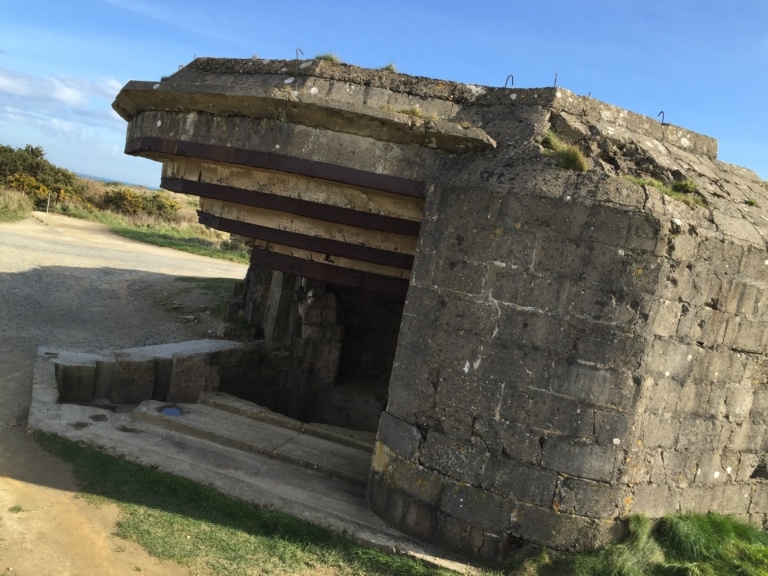
Bayeux – Tapestry
Bayeux is the home of the Bayeux Tapestry, which depicts the events of the Norman conquest of England in 1066. To this day this invasion had an impact on the history of France and England. The French and English languages are affected by this event. The effect of a new ruling class impacts the common folk. Using words to sound more like royalty, new word are now used: mutton from mouton, pork from porc, sir from sieur. It is interesting to go a little deeper and see how so many english words take their origins from the french. While we may say the moon, we refer to all things of the moon as ‘lunar’ from the French lune.
After the conquest, the English aristocracy was replaced by a predominantly french one. French words dominate and get mixed into the English language. To this day examples abound of this crossover and influence. This had the effect of making english less of germanic and saxon. Sometimes the words aren’t easily seen in the first degree but are evident in the second degree. Chicken is poulet. But we refer to all things chicken as poultry. While a wall is a mur, we talk of murals! There are easier and obvious ones like: monet for money, jardin and garden. Others less so. A sales is a vente. But we talk of vendors. Friends is English for ami. But in english we use amicable. Also, a tooth is dent in French, but we speak of dentists and dentistry. You can entertain yourself or amuse yourself, from the French, amuser.
In addition, oyster is huître. But it is less evident in this latter case, but the accent on the i is a vestigial s. The words are essentially the same but for the pronunciation. The same applies to:
- hospital for hôpital,
- crest/crête,
- window and fenestration/fenêtre,
- festival comes from fête,
- hotel and hostel/hôtel,
- master/maître
- cost/coût
- The list goes on…
You can have fun and find many more examples if you dig a little deeper.
Ste-Mere-Eglise
You may have heard the story of Corporal John Steele. On D-Day the first wave of fighters would quietly drop behind the german lines. He was one of the paratroopers descending on Ste-Mère Église. Meanwhile, as the troops prepared for the landing, his parachute would get caught in the steeple of the church. The movie the Longest Day made this moment even more famous. Since then the town continues to honor his legacy and all those who made the ultimate sacrifice. Make sure to find mile ) marker of the road to Liberty. From here, Patton troops would ride to liberate Paris. The war in Europe would end within a year of the landings.
Mont St. Michel
One of the most striking places to see on your trip is Mont St. Michel. No classic high school trip to France is complete without a stop a the ‘merveille’. The magical island situated at the top of the gravity-defying Abbey of Mont Saint-Michel in the bay of Mont Saint Michel is one of France’s most captivating sights. The abbey and its bay are registered as a national historical monument in 1862 and are a UNESCO World Heritage Site since 1979. The remarkable medieval city wall crowned by a large Gothic abbey is one of the first monuments to be declared a UNESCO World Heritage Site in 1979. Mont Saint Michel is not just a church perched on a rock, but an entire medieval town and one of the few places in France to preserve its medieval walls and defenses intact.
According to legend, Archbishop Aubert of Avranches founded the abbey in 708 after the Archangel Michael appeared in a vision to him and made the rocky island in the bay of Mont Saint-Michel a sacred place of pilgrimage. The island became what it is today, in the eighth century, when a local bishop is persuaded by the angel Michael to build a church on the island. From 966 the Duke of Normandy supported the development of a large Benedictine abbey on the mountain.
The Sanctuary of Mont St. Michel is difficult to reach. But in keeping with tradition it is a place of worship dedicated to Saint Michel, a place of pilgrimage frequently visited in the Middle Ages, the seat of a Benedictine abbey with a strong intellectual influence and one of the most important sites of Christian civilization in the Middle East.
Most notably, the nave is on top of the apex of the rocky island.
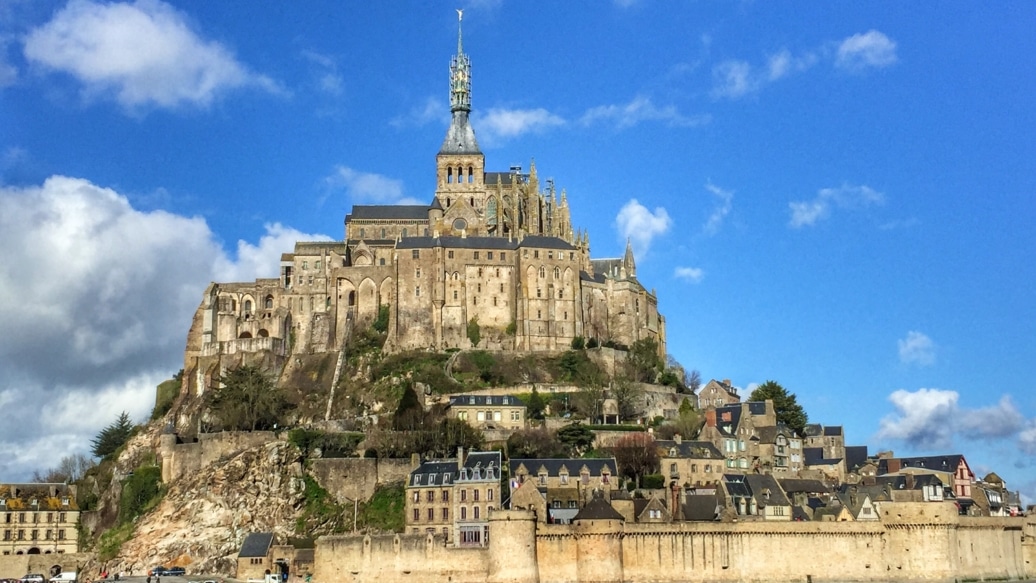
St. Malo
St. Malo is founded here by the Welsh monk St. Maclou who built a church on the site of the Roman town of Alet. The old town is surrounded by medieval ramparts and towers rising above granite villas from the 17th century, and by a cathedral with graceful towers. At the northeastern tip of the city is the Ducal Royal Castle of St. Malo, which houses the city’s historical museum
The city walls of St. Malo are accessible from various points, including from the main gate of the city. On one side, the rampart runs along the coast that includes Quai St. Vincent and Quai St. Louis and overlooks the Grande Porte and the battlements of the 17th century Fort National. Walk through this rampart to the castle gate.
Another famous explorer left the shores from Honfleur. Jacques Cartier explored the St-Lawrence and would be the first to land where Montreal now stands in Quebec.
Loire Valley
The Loire Valley is a UNESCO World Heritage Site in central France. The 1,000 km long Loire originates in the rugged central Ardeche in France and flows into the Atlantic at the port of Saint-Nazaire. The Loire is the longest in France and the thread connecting the area with its tributaries the Cher, Vienne, Indre and other rivers of the region such as the Creuse and the Claise .
In the 15th and 16th centuries, French kings built extravagant country estates in the forests of the Loire and along the river. From huge kennels full of hounds in Cheverny to luxurious stables in Chaumont-sur-Loire, the Loire Valley became a power base and the social centre of the new France enabling the monarchy to run and strut her stuff. When the War of the 15th century faded, the Loire Valley became known as the Garden of France and a location of new and charming castles, châteaux and pleasure palaces.
One notable figure, Leonardo DaVinci, died here in France in 1519 at the Château Clos Lucé. He had been a guest of Francois 1er. He brought some paintings with him, one among them was la “Joconde”, (known as the Mona Lisa) now at the Louvre.. DaVinci burial site is in France at Chateau d”Amboise. After other wars and battles ravaged the region, his burial stone is lost. In 1863, skeletal remains are found on the site. DaVinci’s remains are then transferred to the chapelle St-Hubert not too far from the current Amboise chateau.
Notable châteaux to keep in mind:
- Chambord
- Chenonceau
- Chinon
- Amboise
- Saumur
Chartres
The original cathedral begins construction in 1145 and is later destroyed by fire in 1194. They would rebuild and it would become one of the premier examples of Gothic cathedrals. The appearance of the Gothic cathedral was not only a revolution in architecture; it also introduced new forms in decoration, sculpture, and art.
These cathedrals were the centerpiece of the region they served as the seat of the bishop. Construction techniques would eventually allow to build taller and more imposing structures. Keep in mind these are built stone upon stone. There is no reinforcing steel. Think of them as large individually sculpted lego stones. Moreover, it’s quite an achievement when we think these were built in the 12th to 14th centuries.
Many of these cathedrals took decades to build. And so, masons would pass on their skills to another generation. A young mason might spend his whole life working on only one cathedral.
Gothic Cathedrals
Each stone is carved individually and laid upon the other. Pointed arches are key features as are rib vaulting and flying buttresses. Because of this technique they can build higher structures while allowing for thinner walls. The keystones push down on the rib vaulting. Ultimately, the forces pushing outward transfer to the ‘flying’ buttresses downwards into the anchoring buttresses. The results are awe inspiring. Some cathedral ceilings reach upwards of 150 feet. (Beauvais Cathedral in France). In Chartres they are at 119 feet.
Once the masons have erected the stones sculptors would then carve biblical stories into the church. In those times the masses were ill educated. The church could be seen as an allegorical figure recanting those stories to the local christians.
Thinner walls made stained glass possible. Here more biblical stories adorn the windows. Craftsmen would piece each once until they reached gravity defying heights. 150 of the original 176 windows remain. The church itself is a UNESCO World Heritage site and one of the best-preserved examples of French Gothic architecture.
Customize Your Classic High School Trip to France
But these are just some of the key highlights of the classic high school trip to France. Feel free to make it yours when you work with our team.







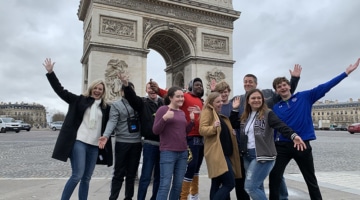
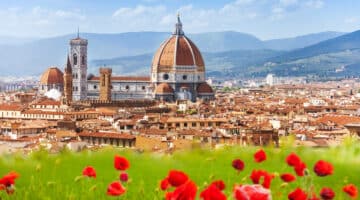
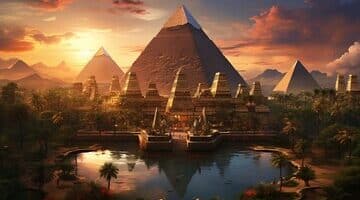
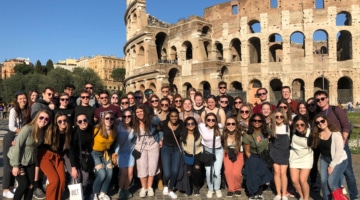
Hello! Looks amazing! Do you have France itineraries planned for summer 2022? 2 incoming sophomore college students interested in taking a trip that got cancelled x2 during 2020.
Hi Anne Marie, check out our Summer Adventure to London and Paris, Summer Adventure to France and Spain, or Nice, Provence and Lyon with Libby trips. All three are available this summer for independent travelers.